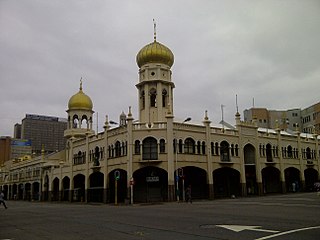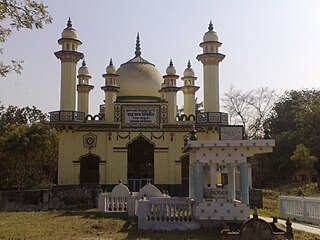The Memon are a Muslim community in Gujarat India, and Sindh, Pakistan, the majority of whom follow the Hanafi fiqh of Sunni Islam. They are divided into different groups based on their origins: Kathiawari Memons, Kutchi Memons and Bantva Memons from the Kathiawar, Kutch and Bantva regions of Gujarat respectively, and Sindhi Memons from Sindh.

Memoni is an Indo-Aryan language spoken by Kathiawari Memons, from the Kathiawar region of Gujarat, India. Memon from Okha Port, Kutch and some other communities from Kathiawad also use Memoni at their homes.

The National Mosque of Malaysia is a mosque in Kuala Lumpur, Malaysia. It has a capacity for 15,000 people and is situated among 13 acres (53,000 m2) of gardens. Its key features are a 73-metre-high (240 ft) minaret and a 16-pointed star concrete main roof. The umbrella, synonymous with the tropics, is featured conspicuously – the main roof is reminiscent of an open umbrella, the minaret's cap a folded one. The folded plates of the concrete main roof are a creative solution to achieving the larger spans required in the main gathering hall. Reflecting pools and fountains are spread throughout the compound. Completed in 1965, the mosque is a bold and modern approach in reinforced concrete, symbolic of the aspirations of a then newly independent nation.
Kutchi Memons are an ethnic group or caste from Kutch in Gujarat, India, who speak the Kutchi language. They are related to the Memons associated with the historic state of Kathiawar, a Muslim community of Pakistan and India, who speak the Memoni language. Transliteration of name of this Memon community has now been standardized. Hence popular usage is Cutchi and Kutchi.

Mawlānā Muhammad Abdullah Ghazi was a Pakistani Islamic scholar who served as Chairman of Ruet-e-Hilal Committee and as the first Imam and Khatib of Lal Masjid, and founded Faridia University and Jamia Hafsa.
The Abdul Aleem Siddique Mosque is a mosque in Singapore that was built as a recognition of Muhammad Abdul Aleem Siddiqi’s propagation of Islam.
Mosques in Kolkata refers to mosques in the city of Kolkata, in India.

Malwali Mosque, Kakrail Markaz is a mosque in the Kakrail neighbourhood of Ramna, Dhaka, Bangladesh. Located near Ramna Park, it is the centre of the Tabligh Jamat in Bangladesh.

Rajabazar is a locality in the city of Kolkata in West Bengal, India. It is located between CIT Road and APC Road. The locality has developed around Narkeldanaga Main Road, which acts as a connector between CIT Road and APC Road. Thus, Rajabazar can be said to be located between Maniktala, Narkeldanga and Sealdah.
The Calcutta Anglo Gujarati School is a private high school in Kolkata, India. It has two school buildings, one for the boys and one for the girls. It is on Pollock Street in the Burrabazar area, the commercial hub of the city.

Jāmi’ah al-Ahmadīyyah is an International Islamic seminary and educational institute with campuses in Pakistan, United Kingdom, India, Ghana, Canada, Germany, Nigeria, Indonesia, Bangladesh, Malaysia, Tanzania, Sri Lanka, Sierra Leone, and Kenya. In addition, there are affiliated Mu'alameen centers in Pakistan and Madagascar. Founded in 1906 as a Section in Madrassa Talim ul Islam by Mirza Ghulam Ahmad of Qadian, the founder of the Ahmadiyya Muslim Community, it is the main centre of the Ahmadiyya Muslim Community for Islamic learning.
Khan Bahadur Fukhr-ut-Tojjar Sir Hajee Ismail Sait was an Indian banker, businessman and Muslim community leader who served as a member of the Madras Legislative Council.

Kharadar is a neighbourhood in District South of Karachi, Pakistan. Kharadar and the adjacent communities of Mithadar and Jodia Bazaar together form what is regarded as the original core of Karachi.

The Juma Mosque of Durban is a mosque located in Durban, Kwazulu-Natal in South Africa. Also known as the Grey Street Mosque, it represents a spiritual center for Durban's Muslims.

Jama Masjid, Bhilai is one of the largest mosques in Chhattisgarh, India, and also in Asia with a capacity to accommodate more than 3000 worshippers at a time. It is the first mosque in the world to be built in the shape of the word "Ya Allah" in Arabic script. It took three years for the construction of the mosque which was completed in 1967.

Jalan Kubor Cemetery, sometimes called Victoria Street Cemetery, is a historical royal Muslim cemetery located at Victoria Street, near Kampong Glam neighbourhood in Singapore. It is one of the oldest Muslim cemeteries in Singapore and houses many graves of important Muslim figures from the 19th and 20th centuries. The cemetery features tombstones with inscriptions in a diversity of languages and writing systems, reflecting the indigenous peoples of Singapore, including Malay, Javanese script, Buginese Lontara script, Arabic, English, Mandarin and Gujarati.
Maulana Nazar-ur-Rehman (مولانا نذر الرحمن) is an Islamic preacher and the current Ameer (Head) of Tablighi Jamaat in Pakistan. Maulana Haji Nazur Rahman, the new leader of Tablighi Jamaat, is from village "Bilawal" of Tehsil and District Rawalpindi. This village is located on the other side of the river Swan, 10 kilometers west of Chakri from Rawalpindi. Before Pakistan Tehsil Fateh Jang was included in Campbellpur district, Maulana Nazur Rahman was born in 1929 in the house of late Hafiz Ghulam Mohiuddin, Hafiz Ghulam Mohiuddin was a pious person and one of the devotees of Hazrat Pir Meher Ali Shah. He used to go to Golra Sharif on foot to meet Pir Saheb due to limited access. The three sons of Hafiz Ghulam Mohiuddin, Haji Hafiz Fazl Hussain, Hafiz Muhammad Siddique alias Muhammad Ji and Maulana Nazarur Rahman were identified as Bamsami.

Moḥammad Abū Bakr Ṣiddīque al-Qurayshī was a Bengali Islamic scholar and the inaugural Pir of Furfura Sharif in West Bengal. He is regarded by his followers, who are scattered across eastern India and Bangladesh, as a mujaddid (reviver) of Islam in the region, due to his significant contributions in religious propagation via the establishment of mosques and madrasas, publication of newspapers and education development in neglected areas. He was the founding president of the sociopolitical Anjuman-i-Wazin-i-Bangla organisation, which advocated for causes such as the Khilafat Movement and Pakistan Movement. Siddique died in 1943, and his shrine is greatly venerated as one of West Bengal's most prominent Sufi centres.
Zakaria Street is a street that joins Rabindra Sarani with Chittaranjan Avenue in Central Kolkata. Nakhoda Mosque is situated in this street. It is the biggest ramadan market in Kolkata. Mohammad Ali Park is located very close to this street. This street is very popular to food bloggers.

The earliest Quran translations into Bengali occurred in 1389, when Shah Muhammad Sagir translated surahs of the Quran into the old Bengali language. However, full translation of the Quran from Arabic to Bengali began in the early nineteenth century.




















